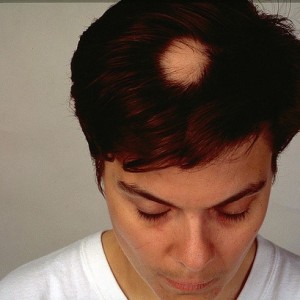Alopecia Areata is a hair loss condition that often manifests as large, round bald patches. This starts occurring as hair falls out in clumps. For reasons that are unclear, the hair follicles are attacked by the immune system. Nonetheless, Alopecia Areata is harmless. The only major effect is on the individual’s appearance.
Hair often grow back. But this often takes between six months to a year before new hair loss episodes start in other regions of the scalp.
Who Is Affected By Alopecia Areata?
Alopecia Areata affects men and women equally. The condition is most often seen in those below the age of twenty. However, there are no age restrictions on who can be affected by it.
Symptom Types
Alopecia Areata can manifest in different forms:
- In some people, the hair does not fall out. Instead, the hair becomes thinner
- In others, the hair grows and then breaks off, leaving stubs that resemble exclamation points
- In 10% of patients, hair never grows back
- In 5% of individuals affected by AA, complete hair loss occurs on both the scalp and the body.
Risk Factors of Alopecia Areata
Those who are most at risk for developing Alopecia Areata may display the following characteristics:
- Profound hair loss is experienced before puberty
- There is a family history of Alopecia Areata
- The individual has a history of autoimmune issues
- Predisposition to various forms of allergies.
How Alopecia Areata Is Diagnosed
Testing for Alopecia Areata can involve:
- sample extracts of hair and skin tissue
- blood tests to help rule out other issues that may involve the thyroid gland.
TREATMENT OPTIONS FOR ALOPECIA AREATA PATIENTS
Hair loss from Alopecia Areata can be treated. However, since the condition is most likely related to genetics, there is no cure at the moment.
Common forms of treatment include the following:
- Corticosteroid injections which reduce inflammation reactions. This is the most common intervention used on AA patients. Injections are usually placed about 1cm apart from each other. Treatments need to be administered every 4-6 weeks. For some people, Rogaine (also known as Minoxidil) can also be used as an adjunct to encourage hair growth
- Contact Immunotherapy requires a weekly application of topical medication on the bald areas. The success rate in research studies is more than 50%. Hair growth can be seen in as little as three months. However, results vary across patients.
- PUVA (Psloralen UVA) uses a drug called Psloralen which sensitizes the skin to controlled amounts of UVA rays. This is often recommended for those who have large areas of hair loss.
Hair transplant procedures may be used to help reverse hair loss, if it is restricted to isolated regions. However, this is not recommended for global coverage since recurrence is very likely. In other words, the immune system may continue to attack the transplanted hair follicles.
Research
The National Alopecia Areata Foundation is currently advancing research initiatives in hopes of developing new treatments or finding a cure for the condition.
In 2010, genetic studies, led by Dr. Angela Christiano, (a member of the National Alopecia Areata Foundation Scientific Advisory Council) was published. The findings revealed some hopeful discoveries.
Many of the genes that are linked with the condition have been identified. They were found to create proteins related to familiar autoimmune disorders. Among these include:
- Celiac disease
- Rheumatoid arthritis
- Diabetes type 1
Alopecia Areata was also found to genetically related to all other forms of autoimmune conditions which have pre-existing treatment forms.
Based on this finding, it is possible for researchers to learn more about the mechanical processes that contribute to Alopeica Areata. And it may be possible to develop specific drug interventions to correct the condition.
Another part of this research includes the development of a genetic test that can actually predict how far the condition will progress.
FREE CONSULTATIONS FOR ALOPECIA AREATA
If you have noticed symptoms of Alopecia Areata, or have received formal diagnosis, you may make an appointment for a complimentary consultation to discuss your condition further with Dr. Umar.
We will then recommend the best treatment intervention for your condition. To schedule a visit, you may fill out our online form located at the top of the page. Or you may give us a call at 877-337-6424.

